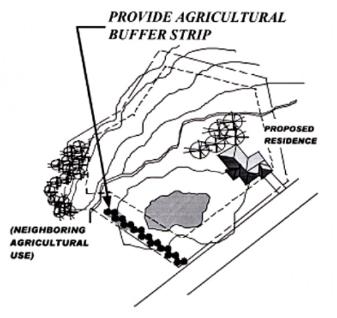Agricultural Buffer Setbacks
To protect commercial agricultural land from potential conflicts with non-agricultural uses, a 200-foot agricultural buffer setback is required between habitable uses (including outdoor areas) and land designated as an Agricultural Resource in the County General Plan. The buffer is measured from the proposed habitable area and/or habitable structure to the property line of the parcel designated as an Agricultural Resource.
Proposals to construct within the 200-foot buffer will be considered by the Agricultural Policy Advisory Commission (APAC) at a public hearing. Examples of common uses that will require approval of an Agricultural Buffer Reduction from the Agricultural Policy Advisory Commission:
- Single Family Dwellings
- Accessory Dwelling Units
- Habitable Accessory Structures
- Outdoor spaces associated with a habitable use such as patios, decks, and swimming pools
- Commercial, industrial, recreational, or institutional structures
- Outdoor areas associated with a commercial, industrial, recreational, or institutional use such as public parking, dining patios, and other areas designed for intensive human use.
Examples of uses which require an administrative approval (no public hearing) of an Agricultural Buffer Reduction:
- Additions to existing residential construction including single family dwellings and habitable accessory structures.
- Additions to existing structures for private recreational facilities
- Agricultural Caretakers’ Mobile Homes
Exceptions to the Agricultural Buffer Requirement:
- Additions of 1,000 square feet or less to an existing legal single-family dwelling that already encroaches into the 200-foot agricultural buffer setback as long as the addition does not encroach further into the 200-foot buffer setback.
In most cases, agricultural buffer reductions can be approved if mitigations to potential or negative impacts to adjacent or surrounding commercial agricultural land are present or proposed on-site. Existing mitigations can include changes in topography, permanent substantial vegetation, or other physical barriers. Proposed mitigations include the establishment of a physical barrier (typically a 6-foot-tall solid wood fence with a vegetative buffer) and the recordation of a Statement of Acknowledgement on the property title which acknowledges the potential for conflicts between the agricultural and non-agricultural uses.
The Agricultural Policy Advisory Commission has approved the following list of recommend plant species for use as vegetative buffers:
Resources:
County Code Section 16.50.095
Recommended Agricultural Buffer Planting List
Recommended Agricultural Buffer Plant List1
Approved by the Agricultural Policy Advisory Commission
 |
| Common Name |
Botanical Name |
| Manzanita |
Arctostaphylos sp. |
| Coyote Brush2 |
Baccharis pilularis |
| California lilac3 |
Ceanothus sp. |
| California buckwheat |
Eriogonum fasciculatum |
| Flannelbush |
Fremontodendron californica |
| Coast silktassel |
Garrya elliptica |
| Toyon4 |
Heteromeles arbutifolia |
| Deergrass |
Muhlenbergia rigens |
| Catalina cherry5 |
Prunus lyonii |
| Holly-leaf cherry |
Prunus ilicifolia |
| Coast Live Oak |
Quercus agrifolia |
| Coffeeberry |
Rhamnus californica |
| Sugar bush |
Rhus ovata |
|
| Notes: |
| 1 |
Refer to UC Extension and California Food and Agriculture websites for current information regarding host plants that may be associated with agricultural pests. |
| 2 |
Not for planting adjacent to rangeland. |
| 3 |
Not for planting adjacent to vineyards. |
| 4 |
Not for planting adjacent to apple or pear orchards. |
| 5 |
Attractive to birds because of their fruit. |
|